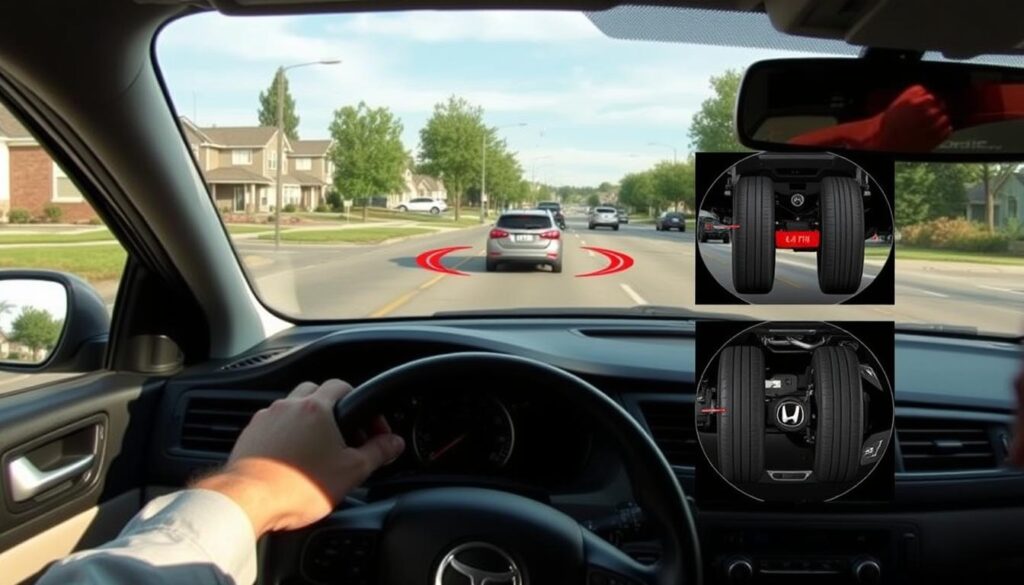Mastering U-Turns and Three-Point Turns
Did you know that over 30% of drivers admit to feeling unsure about performing certain basic driving maneuvers? Changing direction safely is a skill many of us take for granted until we face a missed turn or a dead-end street.
Welcome to your friendly guide for mastering these essential skills. Whether you’re a new driver building confidence or an experienced one refreshing your knowledge, this article is for you. We break down everything you need to know to execute these turns safely and legally.
Knowing the right technique for each situation makes you a more versatile and confident driver. While these maneuvers might seem tricky at first, the proper steps are easy to learn. This guide will cover the key differences between the two turning techniques.
We will also explore important safety considerations and provide clear, step-by-step instructions. Our goal is to help you master both maneuvers with ease.
Key Takeaways
- U-turns and three-point turns are crucial for safely changing your direction of travel.
- Understanding the difference between these maneuvers is key to using the correct one.
- Safety and legality are the top priorities when performing any turning maneuver.
- This guide provides simple, step-by-step instructions for both new and experienced drivers.
- Mastering these skills will significantly boost your confidence on the road.
Getting to Know U-Turns and Three-Point Turns
When you miss a turn or encounter a dead-end street, having the right turning maneuver in your toolkit is essential. Both techniques allow you to completely reverse your direction, but they serve different road conditions.
Defining U-Turns and Three-Point Turns
A standard u-turn involves turning your vehicle 180 degrees to face the opposite direction. This single, continuous motion works best on wider roads with ample space.
The three-point turn serves the same purpose but uses a different approach. This maneuver requires shifting between forward and reverse gears to complete the direction change in tighter spaces.
Key Differences and When to Use Each Maneuver
The main difference lies in the available road width. Choose a u-turn when you have enough room to complete the turn without reversing. This is ideal for broad streets and intersections.
Opt for a three-point turn on narrow residential streets or tight spaces. This technique gives you the control needed to safely change direction when space is limited. Understanding when to use each maneuver makes you a more confident driver.
Legal Guidelines and Safety Precautions

Before you attempt to change direction on any roadway, familiarizing yourself with local regulations can prevent both citations and collisions. Knowing the rules is just as important as mastering the technique.
Understanding Traffic Signs and Local Laws
Always check for posted signs before making any directional change. Look for “No U-Turn” warnings or special permissions like “U-turn only” signs.
Traffic law varies by location, but generally permits this maneuver when there’s no prohibiting sign. You need a green light or arrow and clear visibility.
In residential areas, you may cross a double yellow line if it’s safe. Always ensure pedestrians have cleared the crosswalk completely.
Identifying Situations Where U-Turns Are Prohibited
Several situations strictly prohibit this maneuver. These include one-way streets, railroad crossings, and curves with limited visibility.
Freeways, hills, and areas near fire stations are always off-limits. Business districts typically restrict turns to intersections only.
Weather conditions also matter significantly. Poor visibility from rain or fog makes any turn attempt illegal and unsafe.
Always watch for other vehicles, cyclists, and pedestrians. Understanding your local traffic laws ensures you make safe, legal decisions every time.
Step-by-Step Guide to Performing U-Turns

The key to successful directional reversal lies in following a systematic approach with attention to detail. This section breaks down the process into clear, manageable steps that build your confidence behind the wheel.
Preparing the Vehicle and Assessing Traffic Conditions
Before you make a u-turn, proper preparation ensures safety. Position your car in the far left lane and activate your left turn signal well in advance.
Check all mirrors and blind spots thoroughly. Verify that approaching vehicles are at least 200 feet away and pedestrians have cleared the intersection completely.
Executing the U-Turn with Proper Signaling and Control
When traffic is clear, begin your maneuver smoothly. Turn the steering wheel fully to the left while maintaining brake control throughout the initial phase.
As your vehicle completes the arc, accelerate gently to enter the opposite lane. Always aim for the right lane traveling in the back direction from your starting point.
Expert Tips and Common Pitfalls to Avoid
Practice during low-traffic times to build muscle memory. Keep your foot ready on the brake for immediate control adjustments.
Avoid rushing the steps or turning the wheel prematurely. Thorough blind spot checks prevent collisions with cyclists and motorcycles.
| Preparation Phase | Execution Phase | Key Differences |
|---|---|---|
| Position in left lane | Complete turning arc | Static vs. dynamic movement |
| Signal 100+ feet ahead | Maintain smooth control | Planning vs. action |
| Check traffic conditions | Accelerate gradually | Assessment vs. implementation |
| Verify legal clearance | Enter opposite lane | Safety checks vs. maneuver completion |
Conclusion
Building confidence behind the wheel comes from mastering essential driving maneuvers that every motorist should know. These skills transform unexpected situations into manageable challenges.
Understanding when to use specific turns makes you a safer, more adaptable driver. Proper u-turns require careful planning and legal awareness. Always prioritize safety over convenience.
Practice in low-traffic areas helps build muscle memory. With regular repetition, these maneuvers become second nature. You’ll handle tight spaces and direction changes with ease.
Remember that responsible driving means knowing your limits. If conditions aren’t ideal for u-turns, choose safer alternatives. Your preparedness ensures everyone’s safety on the road.
FAQ
What is the main difference between a U-turn and a three-point turn?
Where are U-turns typically not allowed?
What are the key steps to safely make a U-turn?
How do I know if a U-turn is legal on a particular street?
What is the biggest mistake drivers make when attempting a U-turn?

Sharon Molly is a content creator in lifestyle, fashion, and travel, delivering style-savvy advice and destination insights to inspire confident living. With a background in digital media, she combines aesthetics with practical guidance for modern women on the go.




